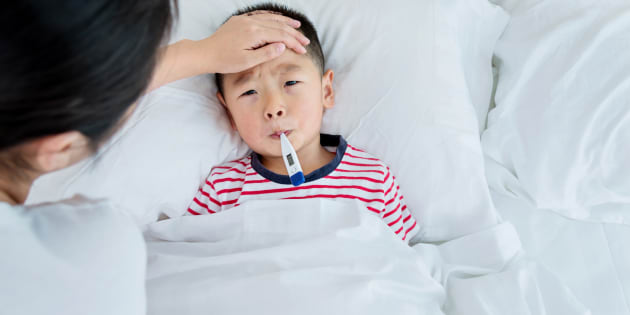
Ah, cold and flu season.
When you have a kid in daycare or school, fall and winter can be a never-ending germ fest. Just as your child gets over one bout of illness — bam! — they catch another (and inevitably, so do you, but somehow 10 times worse).
And when it seems that a runny nose and cough are just part of your kid's life this winter, much like the mittens they'll eventually lose and the boots they always manage to kick off in the car, it can be hard to know at what point they're sick enough to stay home.
A Cold Versus A Flu
Children typically get between three to eight upper respiratory infections (including the common cold) each year, according to Statistics Canada.
Colds are most common in the fall and winter, when people tend to stay indoors and are in close contact with each other, the Canadian Paediatric Society (CPS) explains. Because they're building immunity, children can get as many as eight to 10 colds per year before the age of two, CPS said. A child tends to get fewer colds as they get older, as they become immune to specific strains of cold viruses.
Typical symptoms include a runny nose, coughing, headache, mild sore throat, loss of appetite, fatigue, and a mild fever, according to CPS. A flu, on the other hand, would cause a high fever, cough, and body aches, and a child with the flu would likely feel too sick to get out of bed.
When To Go In
A child with a run-of-the-mill sniffle, runny nose, or a mild cough can still go to school or daycare as long as they're drinking well, don't have a fever, and have a good energy level, Dr. Michael Dickinson, the president of the Canadian Paediatric Society, told HuffPost Canada.
A lot of viruses are contagious before the symptoms start to show themselves, so kids are spreading their germs around before they even get sick, he added.
"Schools and daycares are probably filled with kids with relatively mild symptoms, so adding your kid to the herd probably isn't going to make or break anybody," Dickinson said.
When To Stay Home
Kids with a harsh, persistent cough, or a high fever, or who are vomiting, have diarrhea, pink eye, or a new-onset rash associated with their fever should be kept home until they're either diagnosed and treated or their symptoms go away, Dickinson said.
And if a child's nose is running like a tap, and they're getting bodily fluids all over the place, you might want to keep them home out of courtesy, he added.
When To See A Doctor
Any child who isn't well enough to drink fluids reliably, who has a high fever (over 38.5 C, typically) that persists more than a day or two, or who has a fever in combination with vomiting should see their doctor, Dickinson said.
"Especially in a young child, who could get dehydrated easily, that's someone who should probably seek medical advice sooner rather than later," Dickinson said.
How To Stay Healthy
Washing your hands is one of the best lines of defence, Dickinson said.
It's no trick, the treat is that I have now protected myself, my patients, and my family against influenza this winter! @CanPaedSocietypic.twitter.com/IRUV5GHeTL
— Mike Dickinson (@drmikedickinson) October 31, 2017
"It sounds almost too simple for it to be true, but hand washing is super, super helpful and effective," Dickinson said.
And making sure to get a flu shot — for both kids and adults — will help prevent the spread of influenza, Dickinson added.
The Bottom Line
It would be nice to have a hard and fast rule about when to keep your sick kid home, but it definitely requires a bit of a judgment call, Dickinson said. Parents should listen to their instincts to determine whether their child has a routine cold or something more.
"Parents know. When their kids aren't getting out of bed and they're lethargic and not eating, there's something brewing. That's the time to back off and keep your kid at home," Dickinson said.
And err on the side of caution if you're in doubt, Dickinson added.
"If you're not sure, I would tend towards keeping your child at home to make sure they have a chance to recover and get better and so that they don't spread their germs."
Also on HuffPost:




